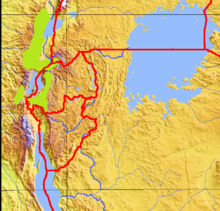Golden monkey
| Golden monkey | ||||||||||||
|---|---|---|---|---|---|---|---|---|---|---|---|---|

copulating golden monkeys |
||||||||||||
| Systematics | ||||||||||||
|
||||||||||||
| Scientific name | ||||||||||||
| Cercopithecus kandti | ||||||||||||
| Matschie , 1905 |
The golden monkey ( Cercopithecus kandti ) is a primate of the genus monkeys ( Cercopithecus ) within the family of Cercopithecidae (Cercopithecidae). It was only recognized as a separate species in 2001, but is still often listed as a subspecies of the diademed monkey ( C. mitis ). Golden monkeys only inhabit a few small areas in the area of the Virunga volcanoes and around Lake Kivu in the countries of the Democratic Republic of the Congo , Uganda and Rwanda .
features
Like the diademed monkey, it has a blue-gray fur, but is characterized by golden-yellow to reddish hair on the back, on the forehead and on the cheeks. Shoulders, arms and legs, the last third of the tail and the top of the head, however, are blackish. The perineum and the underside of the tail base are reddish brown. The hair is yellow at the base and then alternately colored red and black four to seven times. The animals reach a head-trunk length of 57 to 65 cm and have a tail about 80 cm long. The weight of adult males is 8 to 10 kg, that of the smaller females is considerably lighter with 3.3 to 3.5 kg.
Habitat and way of life
Not much is known about their way of life. The golden monkey occurs in mountain forests up to altitudes of over 2300 meters and prefers areas there with bamboo vegetation . The animals were also observed in secondary forests . They live in groups that are dominated by males, and consist of a male with several females or several males, several females and their offspring. The group size is from 3 to over 60 animals, on average 30, and becomes smaller and smaller with increasing height of the habitat. The territory that a group inhabits is 60 to 250 hectares .
The golden monkey's diet mainly consists of young leaves, and fruits, flowers, bark, insects, bird eggs and bamboo shoots are also eaten. The forests in their habitat are poor in edible fruits. Food competitors include the mountain gorilla ( Gorilla beringei beringei ) and the Virunga buffalo ( Syncerus matthewsi ). Reproduction and rearing young have not yet been further researched. Reproduction is probably not seasonally dependent, so it happens all year round.
Hazard and protection
, Comprises less due to the progressive destruction of their habitat of the total than 5000 square kilometers, and the armed conflict in their habitat is the golden monkey from the IUCN as endangered ( endangered ) listed. The golden monkey is found in the following protected areas, in the Kahuzi-Biéga National Park and in the Virunga National Park in the east of the Democratic Republic of the Congo, in the Nyungwe Forest and Volcano National Park in northwest Rwanda and in the Mgahinga Gorilla National Park in Uganda. In the Mgahinga Gorilla National Park, the few remaining animals hybridize with the silver monkey ( Cercopithecus doggetti ).
literature
- Thomas Geissmann : Comparative Primatology. Springer-Verlag, Berlin et al. 2003, ISBN 3-540-43645-6 .
- Don E. Wilson, DeeAnn M. Reeder (Eds.): Mammal Species of the World . A taxonomic and geographic Reference. Johns Hopkins University Press, Baltimore MD 2005, ISBN 0-8018-8221-4 .
Individual evidence
- ↑ Thomas Butynski, Jonathan Kingdon and Jan Kalina (eds.): Mammals of Africa Volume II. Primates. Bloomsbury, London, 2013, ISBN 978-1-4081-2252-5 , pp. 330–334.
- ↑ a b c d Elizabeth L. Gadsby, Colin P. Groves, Aoife Healy, K. Praveen Karanth, Sanjay Molur, Tilo Nadler, Matthew C. Richardson, Erin P. Riley, Anthony B. Rylands, Lori K. Sheeran, Nelson Ting, Janette Wallis, Siân S. Waters & Danielle J. Whittaker: Family Cercopithecidae (Old World Monkeys). Page 695 in Russell A. Mittermeier , Anthony B. Rylands & Don E. Wilson : Handbook of the Mammals of the World: - Volume 3. Primates. Lynx Editions, 2013 ISBN 978-8496553897
- ↑ Cercopithecus mitis ssp. kandti in the endangered Red List species the IUCN 2006 Posted by: T. Butynski & Members of the Primate Specialist Group, 2000. Accessed June 24 of 2008.

